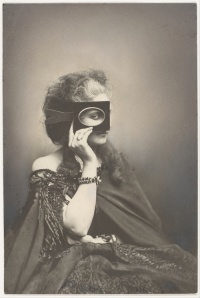Vignetting
From The Art and Popular Culture Encyclopedia

|
Related e |
|
Featured: |
In photography and optics, vignetting (from French "vignette") is a reduction of an image's brightness or saturation at the periphery compared to the image center. The word vignette, from the same root as vine, originally referred to a decorative border in a book. Later, the word came to be used for a photographic portrait which is clear in the center, and fades off at the edges. A similar effect occurs when filming projected images or movies off a projection screen. The resulting so-called "hotspot" effect defines a cheap home-movie look where no proper telecine is used.
Vignetting is often an unintended and undesired effect caused by camera settings or lens limitations. However, it is sometimes purposely introduced for creative effect, such as to draw attention to the center of the frame. A photographer may deliberately choose a lens which is known to produce vignetting to obtain the effect, or it may be introduced with the use of special filters or post-processing procedures.
Contents |
Causes
There are several causes of vignetting. Sidney F. Ray distinguishes the following types:
- Mechanical vignetting
- Optical vignetting
- Natural vignetting
A fourth cause is unique to digital imaging:
- Pixel vignetting
Mechanical vignetting
Mechanical vignetting occurs when light beams emanating from object points located off-axis are partially blocked by external objects such as thick or stacked filters, secondary lenses, and improper lens hoods. This has the effect of changing the entrance pupil shape as a function of angle. The darkening can be gradual or abrupt, depending on the lens aperture. The smaller the aperture, the more abrupt the vignetting as a function of angle. Complete blackening is possible with mechanical vignetting (when the corner of the image is essentailly imaging the inside of the lens hood or filter holder).
Optical vignetting
This type of vignetting is caused by the physical dimensions of a multiple element lens. Rear elements are shaded by elements in front of them, which reduces the effective lens opening for off-axis incident light. The result is a gradual decrease in light intensity towards the image periphery. Optical vignetting is sensitive to the lens aperture and can be completely cured by a reduction in aperture of 2–3 stops. (An increase in the F-number.)
Natural vignetting
Unlike the previous types, natural vignetting (also known as natural illumination falloff) is not due to the blocking of light rays. The falloff is approximated by the cos4 or "cosine fourth" law of illumination falloff. Here, the light falloff is proportional to the fourth power of the cosine of the angle at which the light impinges on the film or sensor array. Wideangle rangefinder designs and the lens designs used in compact cameras are particularly prone to natural vignetting. Telephoto lenses, retrofocus wideangle lenses used on SLR cameras, and telecentric designs in general are less troubled by natural vignetting. A gradual grey filter or postprocessing techniques may be used to compensate for natural vignetting, as it cannot be cured by stopping down the lens. Some modern lenses are specifically designed so that the light strikes the image parallel or nearly so, eliminating or greatly reducing vignetting. Almost all lenses designed for the Four Thirds system are of this type, as telecentricity is a stated design goal.
Pixel vignetting
Pixel vignetting only affects digital cameras and is caused by angle-dependence of the digital sensors. Light incident on the sensor at a right angle produces a stronger signal than light hitting it at an oblique angle. Most digital cameras use built-in image processing to compensate for optical vignetting and pixel vignetting when converting raw sensor data to standard image formats such as JPEG or TIFF. The use of microlenses over the image sensor can also reduce the effect of pixel vignetting.
Post-shoot
For artistic effect, vignetting is sometimes applied to an otherwise un-vignetted photograph and can be achieved by burning the outer edges of the photograph (with film stock) or using digital imaging techniques, such as masking darkened edges. The Lens Correction filter in Photoshop can also achieve the same effect.
In digital imaging, this technique is used to create a lo-fi appearance in the picture.
See also

